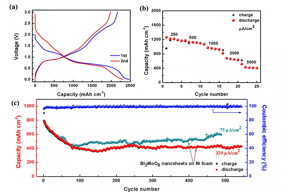

| Date | 28th, Jun 2018 |
|---|
Home > Press > BNAs improve performance of Li-ion batteries
 Fig. (a) are the galvanostatic charge-discharge curves of BNAs integrated electrode at a current density of 25 μA cm-2 . The 1st, 2nd discharge capacities of BNAs integrated electrode are 2471.5, 2311.7 μAh'cm-2 (1861.8, 1741.4 mAh g-1). Fig. (b) reveals the rate capability of BNAs integrated electrode at current densities of 250, 500, 1000, 2000, 5000 μAh'cm-2 respectively. The discharge capacities are 1219, 1128, 972, 678, 430 μAh'cm-2 (918.2, 849.7, 732.2, 510.7, 323.9 mAh g-1), respectively. Fig. (c) shows the cycling stability of BNAs integrated electrodes. Reversible capacity of BNAs integrated electrodes can maintain a capacity of 410 μAh'cm-2 (308.8 mAh g-1, at a current density of 320 μAh'cm-2) after 600 cycles. When the current density was 75 μAh'cm-2, the electrode exhibits a high capacity of 600 μAh'cm-2 (451.9 mAh g-1) after 500 cycles. The above results show that the integration of active material and current collector can greatly improve the capacity, rate ability and cyclical stability of the battery.
CREDIT
Shuang Yuan, Associate Prof. Department of New Energy Science & Engineering, School of Metallurgy Key Laboratory of Electromagnetic Processing of Materials (Ministry of Education) Northeastern University, China Tel: +86-24-8368 1171 E-mail: yuanshuang@ciac.ac.cn Add: Box314, Northeastern University, Shenyang, 110819, China
Fig. (a) are the galvanostatic charge-discharge curves of BNAs integrated electrode at a current density of 25 μA cm-2 . The 1st, 2nd discharge capacities of BNAs integrated electrode are 2471.5, 2311.7 μAh'cm-2 (1861.8, 1741.4 mAh g-1). Fig. (b) reveals the rate capability of BNAs integrated electrode at current densities of 250, 500, 1000, 2000, 5000 μAh'cm-2 respectively. The discharge capacities are 1219, 1128, 972, 678, 430 μAh'cm-2 (918.2, 849.7, 732.2, 510.7, 323.9 mAh g-1), respectively. Fig. (c) shows the cycling stability of BNAs integrated electrodes. Reversible capacity of BNAs integrated electrodes can maintain a capacity of 410 μAh'cm-2 (308.8 mAh g-1, at a current density of 320 μAh'cm-2) after 600 cycles. When the current density was 75 μAh'cm-2, the electrode exhibits a high capacity of 600 μAh'cm-2 (451.9 mAh g-1) after 500 cycles. The above results show that the integration of active material and current collector can greatly improve the capacity, rate ability and cyclical stability of the battery.
CREDIT
Shuang Yuan, Associate Prof. Department of New Energy Science & Engineering, School of Metallurgy Key Laboratory of Electromagnetic Processing of Materials (Ministry of Education) Northeastern University, China Tel: +86-24-8368 1171 E-mail: yuanshuang@ciac.ac.cn Add: Box314, Northeastern University, Shenyang, 110819, China
Abstract: Recent research published in a paper in NANO by a group of researchers from Northeastern University investigate the effect of hierarchical Bi2MoO6 nanosheet arrays growing on three-dimensional Ni foam synthesized by one-step template-free route. The obtained BNAs used directly as binder-free integrated electrode for Li-ion batteries (LIBs) exhibits a super high reversible discharge capacity of 2311.7 μAh/cm2, and an excellent cycle stability.
Singapore | Posted on June 27th, 2018
With the rapid development of modern technology, a variety of portable electronic products have become the requirement of time. Li-ion batteries (LIBs) are the optimum selection by virtue of long cycle-life and high energy density properties. Meanwhile, LIBs are viewed as one of the most promising technology in various fields including the defense industry, space technology, electric vehicles and other fields. Nowadays, commercial LIBs mainly use graphite as the anode material. However, graphite can hardly provide the high capacity and high energy density necessary to satisfy the demand required for high power application of the next-generation LIBs due to its low theoretical specific capacity.
Thus, development of high-performance anode materials with high capacity as well as low insertion voltage is urgently needed. In terms of their high capacity, lots of metal oxides have attracted great interest in recent years. However, most metal oxides have low conductivity, high desertion voltage and structural instability, which result in poor rate capability, low power density and poor cycling stability. These shortcomings limit the application of metal oxides as anode materials for LIBs.
Among the numerous metal oxides, Bi2MoO6 with high theoretical capacity (791 mAh/g) and low desertion voltage (
